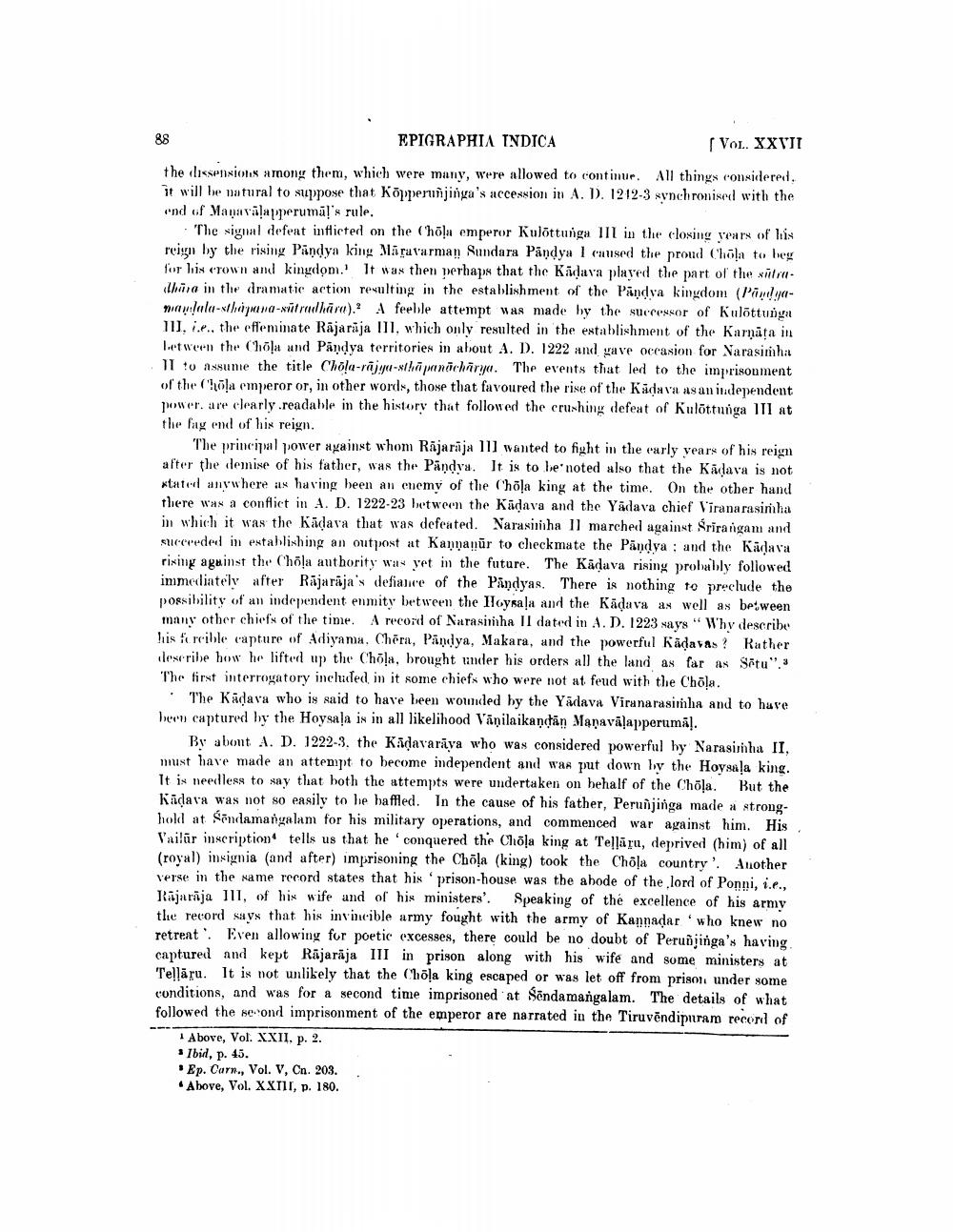________________
EPIGRAPHIA INDICA
Vol. XXVII
the dissensions among them, which were many, were allowed to continur. All things considered. it will be natural to suppose that Kõpperunjinga's accession in A. 1). 1212-3 synchronised with the end of Manavalapperumā!'s rule.
The Nigual defeat intricted on the (hoļu emperor Kulöttunga in in the closing wears of his reign by the rising Pandya king Māruvarman Sundara Pandya 1 caused the proud Chola to heg for his crown and kingdom. It was then perhaps that the Kādava played the part of the sitrathira in the dramatic action resulting in the establishment of the Pandva kingdom (Panyamawala-sthiyara-sitruul hara). A feeble attempt was made by the successor of Kulõttung III. ... the efleminate Rājarija III, which only resulted in the establishment of the Karnāta in Letween the Chola and Pandya territories in about A. D. 1222 and gave occasion for Narasimhat 11 to assume the title Chola-rajyo-siliāpondchirya. The events that led to the imprisonment of the l'
ha emperor or, in other words, those that favoured the rise of the Kadara as an independent power are clearly.readable in the history that followed the crushing defeat of Kulottunga lll at the fay end of his reign.
The principal power nyainst whom Rāja rāja Ill wanted to fight in the early years of his reign after the demise of his father, was the Pândva. It is to be noted also that the Kādava is not xtate anywhere as having been an enemy of the Chõļa king at the time. On the other hand there was a conflict in A. D. 1222-23 between the Kādava and the Yadava chief Viranarasimha in which it was the Kadava that was defeated. Narasimha Il marched against Srirangam and succeeded in establishing an outpost at Kannanūr to checkmate the Pandya : and the Kädava rising against the Chola authority was yet in the future. The Kādava risiny probably followed immediately after Rajaraja's defiance of the Pandyas. There is nothing to preclude the possibility of an independent enmity between the lloysala and the Kädava as well as between many other chiefs of the time. A record of Narasimha ll dated in A.D. 1223 says "Why describe his ferrible capture of Adiyama. Chēra, Pandya, Makara, and the powerful Kadavas ? Rather describe how he lifted up the Chola, brought under his orders all the land as far as Sētu". The first interrogatory included in it some chiefs who were not at feud with the Chola.
• The Kadava who is said to have been wounded by the Yadava Viranarasimha and to have Deo captured by the Hoysala is in all likelihood Vānilaikandan Manavalapperumā!.
By abont A. D. 1222-3, the Kādavarāya who was considered powerful hy Narasiviha II, must have made an attempt to become independent and was put down lwy the Hoysala king. It is needless to say that both the attempts were undertaken on behalf of the Chola. But the Kādara was not so easily to be baffled. In the cause of his father, Peruījinga made a stronghold at Sendamangalam for his military operations, and commenced war against him. His Vailûr inscription tells us that he conquered the Chola king at Telläru, deprived (him) of all (royal) insignia (and after) imprisoning the Chõļa (king) took the Chola country'. Another verse in the same record states that his prison-house was the abode of the lord of Ponni, i.e., Rajaraja lll, of his wife and of his ministers'. Speaking of the excellence of his army the record says that his invincible army fought with the army of Kannadar 'who knew no retreat! Even allowing for poetic excesses, there could be no doubt of Perunsinga's having captured and kept Rājarāja III in prison along with his wife and some ministers at Tellāru. It is not unlikely that the Choļa king escaped or was let off from prison under some conditions, and was for a second time imprisoned at $endamangalam. The details of what followed the second imprisonment of the emperor are narrated in the Tiruvēndipuram record of
Above, Vol. XXII. p. 2. * Ibid, p. 45. * Ep. Carn., Vol. V, Cn. 203. Above, Vol. XXIII, p. 180.




